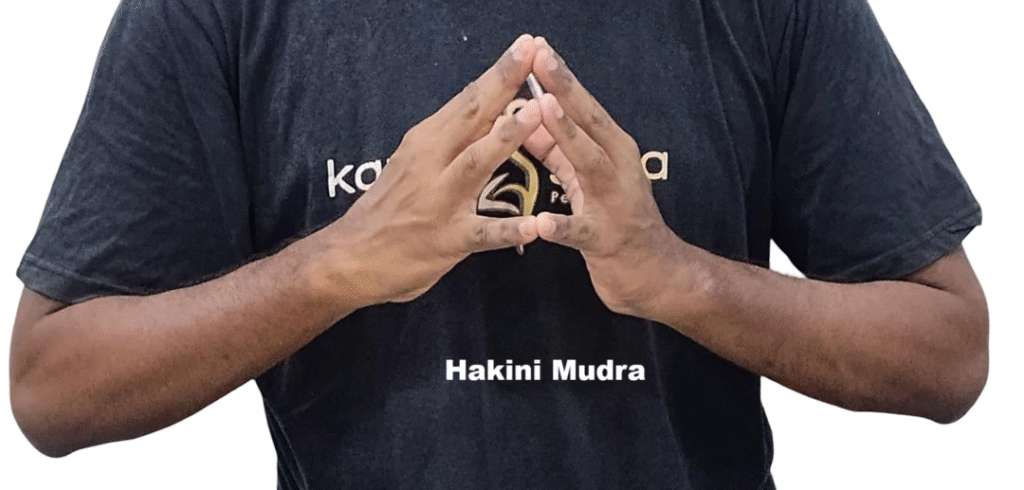Hakini Mudra (Mudra of the Mind)
Introduction
Hakini Mudra, often referred to as the Mudra of the Mind, is a yogic hand gesture designed to enhance mental power, focus, and cognitive function. It is commonly used in meditation, pranayama, and yoga therapy to promote concentration, memory, and mental clarity.
Hakini Mudra is especially beneficial for balancing brain hemispheres, stimulating prana flow, and enhancing decision-making skills.
Meaning
Etymology:
Hakini is associated with the mind and intellect in yogic traditions.
Mudra means gesture or seal.
Symbolism:
Represents mental unity, focus, and cognitive empowerment.
Encourages clarity of thought, memory enhancement, and brain synchronization.
Symbolically connects the practitioner with mental energy and intuitive intelligence.
How to Perform Hakini Mudra
Sit comfortably in a meditation posture (Sukhasana, Padmasana, or Vajrasana) with a straight spine.
Bring your palms in front of the chest, facing each other.
Touch tips of all fingers of the left hand to the corresponding tips of the right hand (thumb to thumb, index to index, middle to middle, ring to ring, little to little).
Keep the fingers gently pressed together, without tension.
Maintain relaxed shoulders and elbows slightly bent.
Close your eyes and focus on slow, deep breathing, visualizing mental energy harmonizing and intelligence expanding.
Maintain this mudra for 5–15 minutes, once or twice daily.
Tip: Practicing in a quiet environment enhances mental clarity and focus.
Benefits
Enhances memory, focus, and concentration.
Stimulates brain activity and cognitive function.
Promotes mental clarity, decision-making, and problem-solving ability.
Balances left and right brain hemispheres, improving creativity and logic.
Reduces stress, anxiety, and mental fatigue.
Supports energy flow and pranic balance in the brain and nervous system.
Contraindications
Avoid if there is pain, injury, or inflammation in fingers, hands, or wrists.
People with arthritis or joint limitations should practice gently.
Stop if discomfort or strain occurs.
Anatomy & Physiology
Involves phalanges, interphalangeal joints, intrinsic hand muscles, and forearm muscles.
Stimulates median, ulnar, and radial nerve endings, enhancing sensory perception and cortical activity.
Improves blood circulation in hands and forearms, indirectly benefiting the autonomic nervous system.
Supports relaxation in shoulders, upper back, and chest, facilitating deeper breathing and pranic flow.
Kinesiology
Isometric contraction of thenar, hypothenar, and interossei muscles maintains finger contact.
Engages forearm, shoulder, and upper back muscles for stability.
Enhances fine motor coordination, proprioception, and hand awareness.
Promotes mind-body integration through deliberate finger placement and focus.
Neurology
Activates median, ulnar, and radial nerves, stimulating the somatosensory and motor cortices.
Enhances parasympathetic nervous system activity, reducing stress and mental tension.
Strengthens neural pathways associated with memory, attention, and brain hemisphere coordination.
Visualization and mindful practice improve mental energy, clarity, and cognitive resilience.
Duration of Practice
Beginners: 5 minutes daily.
Intermediate/Advanced: 10–15 minutes, once or twice daily.
Can be combined with meditation, pranayama, or concentration exercises.
Counter Mudra
Gyana Mudra or Prana Mudra can act as counter mudras to stimulate vitality and maintain energy balance after Hakini Mudra practice.
Alternating Hakini Mudra with these mudras balances mental focus with energetic activation.
Conclusion
Hakini Mudra is a powerful gesture for enhancing mental clarity, focus, and cognitive function. Regular practice improves memory, decision-making, brain hemisphere balance, and overall mental energy, making it a valuable tool for meditation, pranayama, and yoga therapy.
FAQ
Q1: Can Hakini Mudra improve memory?
A1: Yes, it stimulates brain activity and enhances memory retention and recall.
Q2: Can children practice it?
A2: Yes, with guidance to ensure comfort and proper finger alignment.
Q3: Is visualization necessary?
A3: Visualization enhances benefits, but finger contact and mindful breathing alone are effective.
Q4: Can it be combined with other mudras?
A4: Yes, especially with meditation, pranayama, or cognitive enhancement practices.
References
Swami Satyananda Saraswati, Mudras for Healing and Transformation, Bihar Yoga Publications, 2012.
Dr. Harish Johari, Mudra: The Gateway to Health, Inner Traditions, 1994.
B.K.S. Iyengar, Light on Yoga, HarperCollins, 2005.
Yoga Journal, Hakini Mudra for Mental Clarity and Focus, 2018.
Hatha Yoga Pradipika and yogic texts on meditation, prana, and cognitive enhancement.
